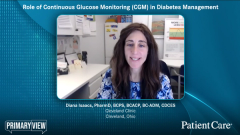
Future CGM Advancements for Diabetes Management
Diana Isaacs, PharmD, BCPS, BCACP, BC-ADM, CDCES, evaluates upcoming CGM advances in the pipeline for the management of diabetes.
Episodes in this series
Diana Isaacs, PharmD, BCPS, BCACP, BC-ADM, CDCES: There’s a lot of excitement in the CGM [continuous glucose monitor] landscape. There are a number of companies working on less invasive CGM. All the current systems require it being a sensor that’s placed under the skin, but there’s interest in different types, like watches, that sit on the skin that would be a little less invasive. There are a lot of companies working on that that we’ll likely see in the upcoming years.
More in the near future is Freestyle Libre 3 System, which is available in Germany and some other places in Europe. Basically, it looks like the Freestyle Libre 2 System, only smaller. It’s the size of 2 pennies instead of 2 quarters, so it will be a bit tinier. The biggest difference with Libre 3 is that it will be real-time CGM. Libre 2 is what we consider intermittently scanned. You need to scan with a reader or smartphone to see the reading. It has real-time alarms that go off regardless of whether a person is scanning or not. But to see the reading, you have to scan. The Libre 3 will become more of a true real-time CGM where a person could look at it at any time and see their reading. We look forward to that coming in the future and seeing more data on that.
Medtronic has the Guardian 4, which is already available in Europe, but isn’t yet available in the United States. It’s similar to the Guardian 3 in a lot of ways. However, it won’t require calibrations. That will be a huge enhancement of the current sensor. They have another one that they plan to submit to the FDA after they hear back about Guardian 4 that’s more similar to the Libre and what we expect from Dexcom G7, in that it will be a fully disposable transmitter sensor combination and also wouldn’t require calibrations. There’s lots of excitement there.
There’s another thing I wanted to mention. Time in range is big. That’s the time spent between 70 and 180 mg/dL. There’s a big movement to use that to evaluate new medications and move away from an A1C [glycated hemoglobin]–centric diabetes culture. What I find interesting is there’s also time in tighter range, which is the time spent between 70 and 140 mg/dL. More studies are starting to look at this tighter range and compare differences. Especially when you think about people with prediabetes or are maybe at risk of diabetes, time in tighter range may be more informative. There’s a lot of excitement. The 2022 ATTD [International Conference on Advanced Technologies and Treatments for Diabetes] will be coming up at the end of April, and there should be a number of studies that report out and lots of exciting information.
Transcript Edited for Clarity
Newsletter
Enhance your clinical practice with the Patient Care newsletter, offering the latest evidence-based guidelines, diagnostic insights, and treatment strategies for primary care physicians.

















































































































































































































































































